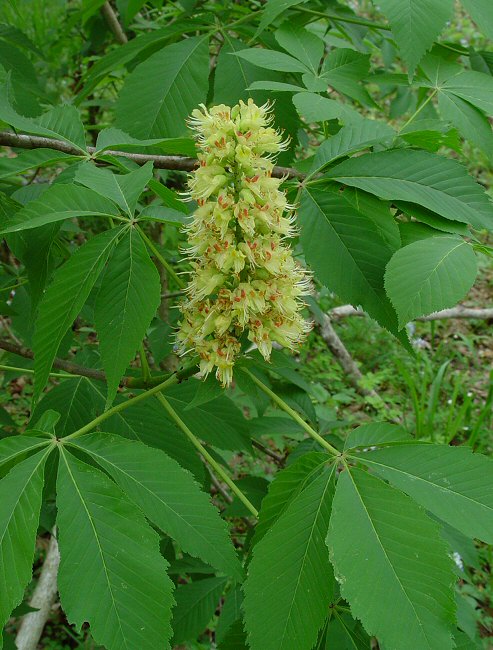Aesculus glabra Willd.
Ohio Buckeye

Native
CC = 5
CW = 3
MOC = 78
© DETenaglia
Aesculus glabra Willd.Ohio Buckeye | |
 |
Native CC = 5 CW = 3 MOC = 78 |
© DETenaglia |
|
Family - Sapindaceae Habit - Shrub or tree to 20 m tall. Stems - Woody, to 20 m, with a single trunk or multiple trunks. Bark variable.
Leaves - Opposite, palmately compound, petiolate. Leaflets typically 5, but sometimes 6 or 7, 3-8cm wide, 15cm long, serrate, pubescent below, glabrous above, acuminate. Petiolules to 1cm long.
Inflorescence - Terminal panicle to 20cm long on new season growth. Axis of inflorescence densely pubescent with multicellular hairs. Pedicels pubescent, to 8mm long in flower.
Flowers - Petals 4, pale yellow to creamy whitish, clawed. Claws of upper petals to 3.5mm long, with dense tuft of villous pubescence at apex. Limb of upper petals +1.5cm long, 4mm broad at apex, with reddish spot near base of limb, pubescent. Lower petals with claw to 3.5mm long. Limb of lower petals +1cm long, 8-9mm broad, pubescent. Stamens 7, exserted. Filaments villous, to -2cm long, white. Anthers orange-red, 2mm long. Ovary 6mm long, dense villous at base but glabrous and reddish at apex. Calyx tube to 7mm long, 5mm in diameter, 5-lobed, yellow-green, pubescent. Lobes to 3mm long, obtuse, pubescent. Fruits globose, spiny, 2.5-6cm in diameter. Seeds 2 per fruit, +/-3cm in diameter, shiny, dark brown.
Fruits - Capsules, 2-4 cm long, ovoid, leathery, dehiscent longitudinally, 1-3-seeded. Seeds 2-4 cm long, variously depressed-globose, smooth, shiny, reddish brown with a large, pale, attachment scar.
Flowering - April - May. Habitat - Wooded slopes, ravines, thickets, open, rich woods, also cultivated. Origin - Native to the U.S. Lookalikes - None when flowering. Vegetatively resembles A. pavia. Other info. - This species can be found throughout most of Missouri except the extreme southeastern and northwestern corners of the state. The tree is easy to identify because of its palmately divided leaves (which are opposite) and its big inflorescences. The buds are easy to ID in winter also as they are quite large and the tree generally has a widely spreading growth habit. This species deserves to be cultivated more and it grows easily from seed. The fruits of the plant split into three parts, with large, attractive shiny seeds (buckeyes) inside. Some sources claim that the seeds can be eaten if roasted first, but the raw seeds are mildly poisonous. Native Americans have used crushed buckeyes to tranquilize fish to make them easier to catch. The large seeds have been carried in the pocket for their pleasantly smooth texture, as good luck charms, and as a folk remedy for rheumatism. Photographs taken in the Ozark Scenic Riverways, Shannon County, MO., 10-6-03, Whetstone Creek Conservation Area, Callaway County, MO., 2-19-04, and Earthquake Hollow Conservation Area, Callaway County, MO., 4-15-04 (DETenaglia); also at Rockwoods Reservation, St. Louis County, MO, 9-20-2010, Little Lost Creek Conservation Area, Warren County, MO, 3-30-2012, St. Francois State Park, St. Francois County, MO, 3-28-2016, Young Conservation Area, Jefferson County, MO, 5-7-2018 and 4-15-2020; and Bootleg Access, Washington County, MO, 9-16-2024 (SRTurner). |